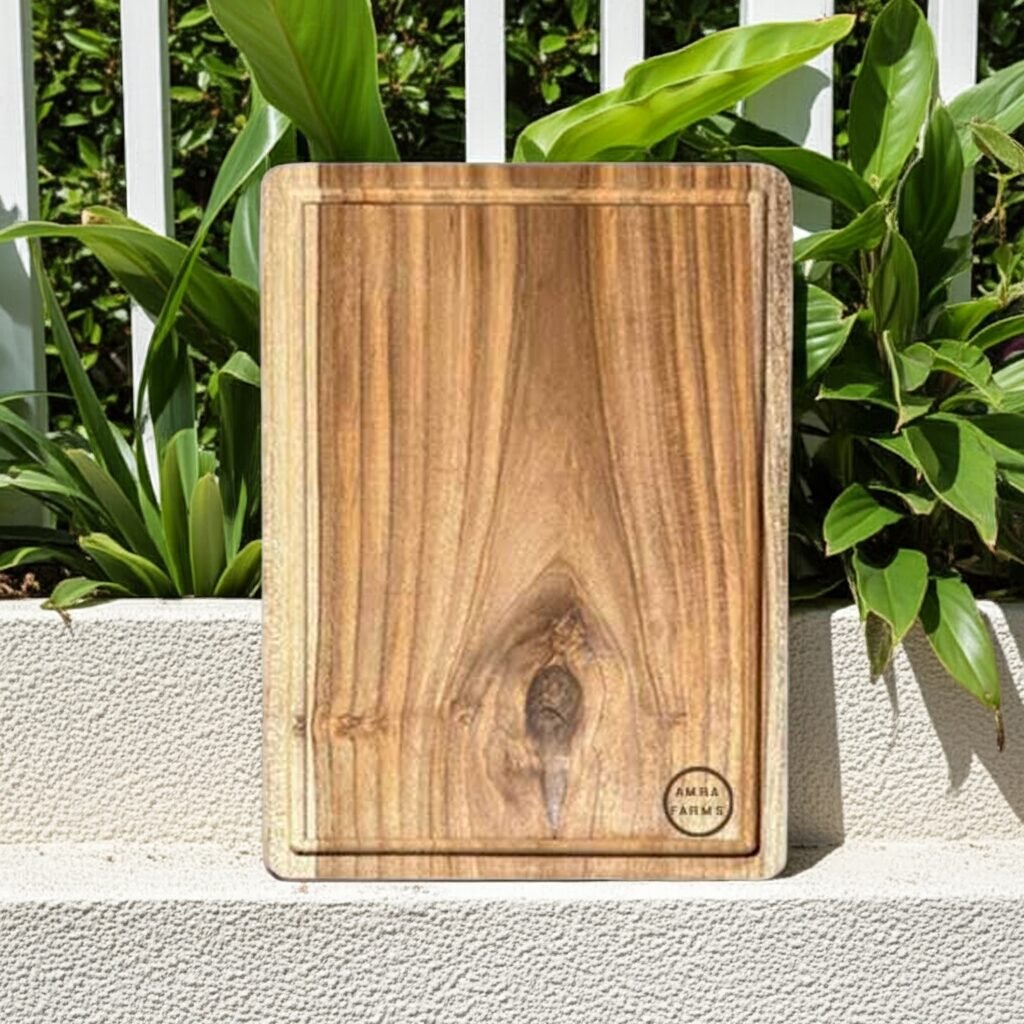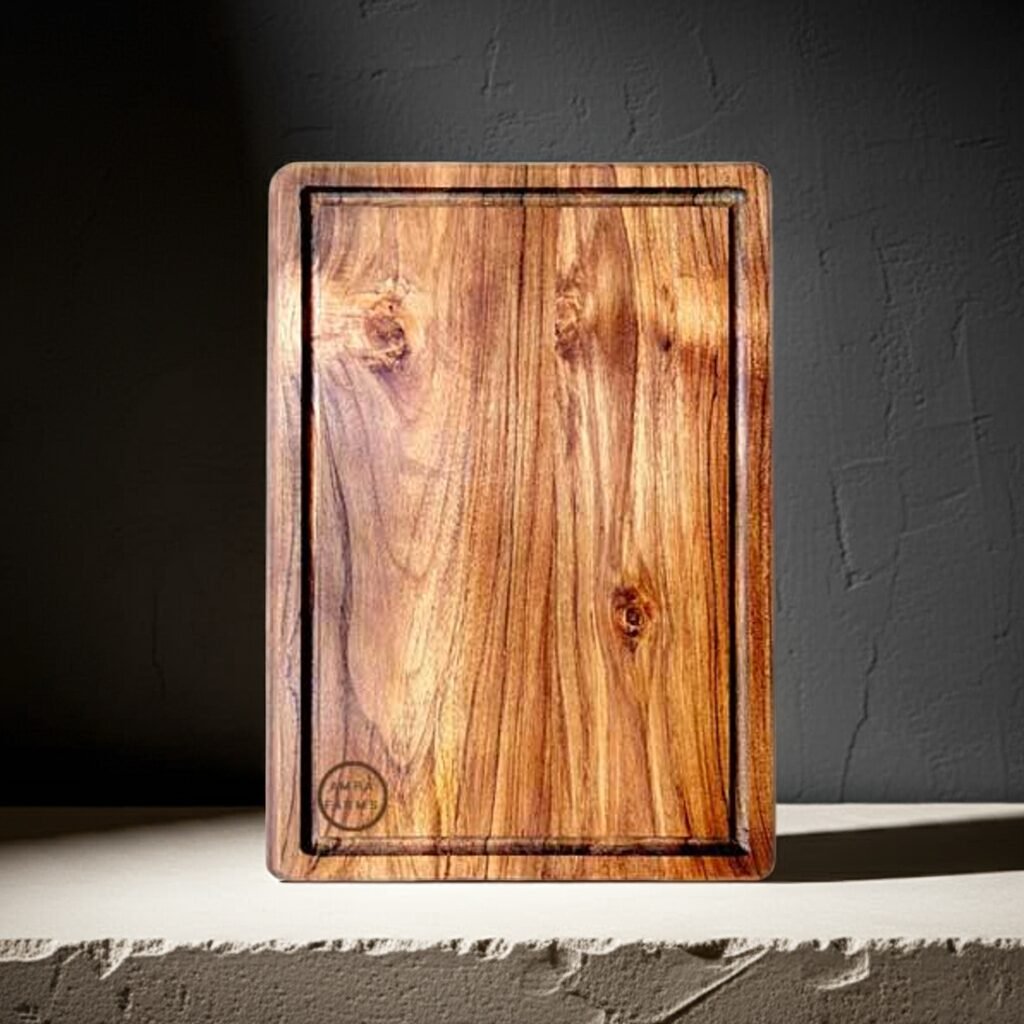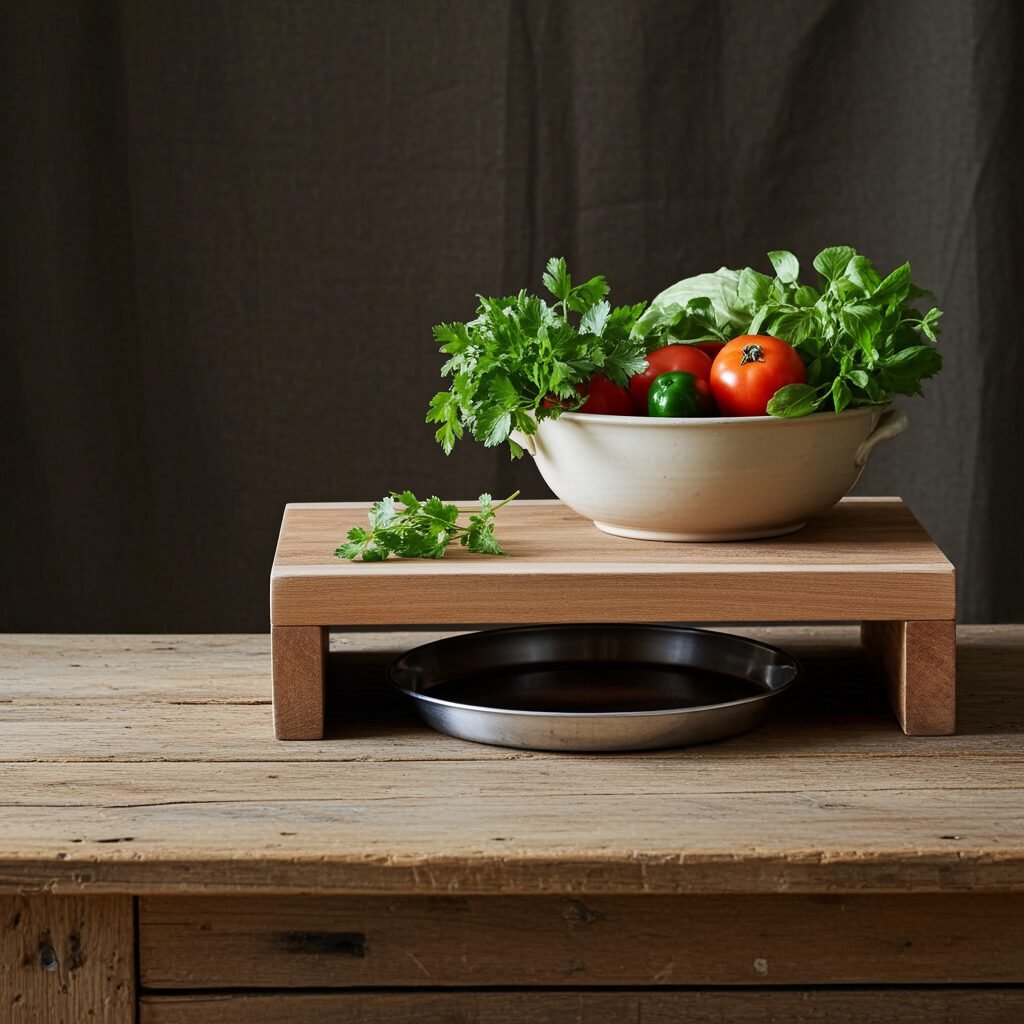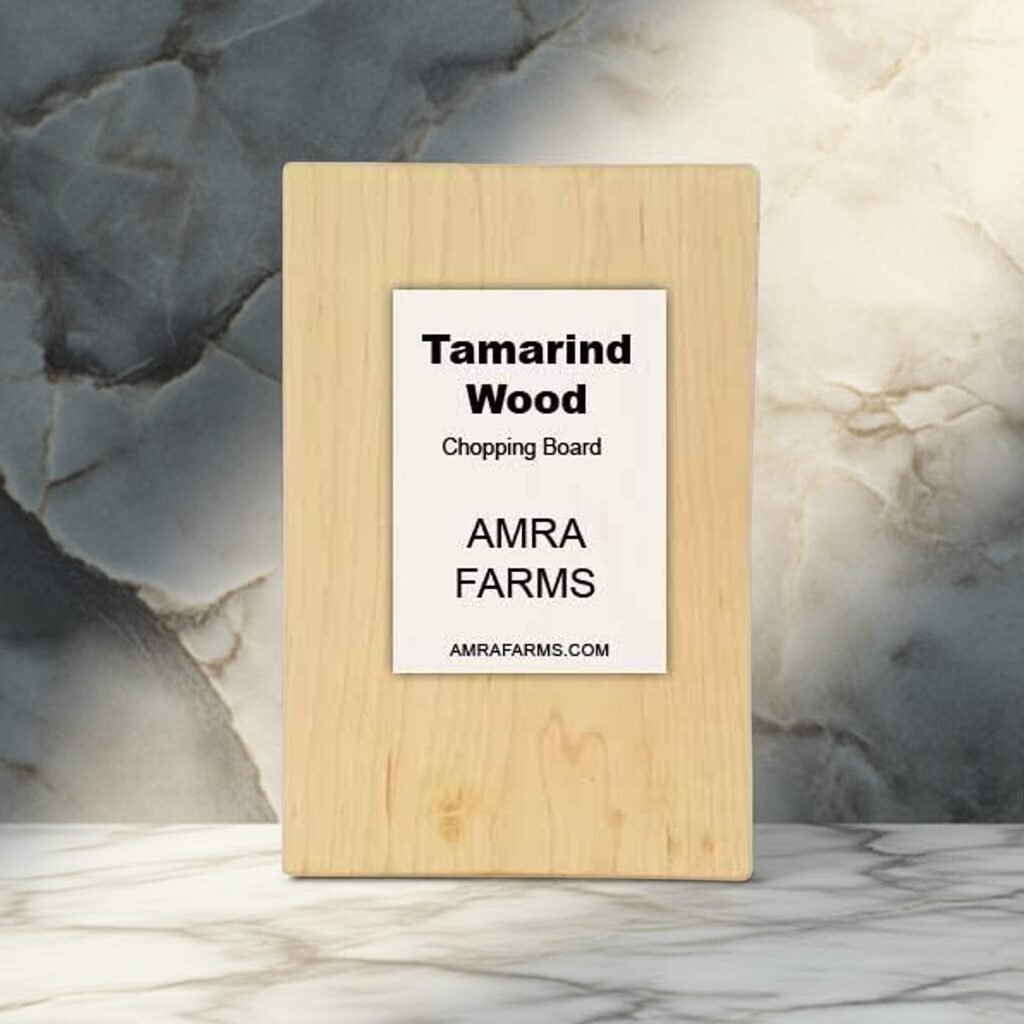Your cart is currently empty!
Wooden Vegetable Cutting Boards: The Ultimate Guide to Eco-Friendly & Durable Chopping
Over the years, people have experimented with various materials for cutting boards including bamboo, plastic, steel and even stone. But wood has been the timeless companion for chefs and cooks worldwide for cutting vegetables. Its durability, sustainability and eco-friendliness contribute to the affinity to wooden cutting boards but the features of wood are unlimited, making it the most reliable cutting surface for vegetables. This article explores wooden cutting boards, specifically designed to cut vegetables and what you should consider while purchasing a wooden cutting board for vegetables.






Benefits of Using a Wooden Cutting Board for Vegetables
Most people believe that you can cut vegetables on any board. They are not contagious and do not pass on bacteria and practically have none unless they are spoilt. But this does not mean that you can use just about any board. On the contrary, vegetables are different from meat and fish. They come in a range of challenges when it comes to density and size. While most vegetables are just not as dense, some are really dense. They could be juicy like a tomato (I know it’s a fruit technically), there are others that aren’t that juicy like a potato. The varieties of vegetables make it difficult to choose the right board. A wooden board is perfect for cutting vegetables for a reason. Some of these include:
Durability: A vegetable cutting board should be durable and should last long. When it comes to durability, wooden boards outlast plastic boards by years, often serving your purpose for decades and not years. Wood like teak and tamarind are perfect for cutting vegetables as they are tough and dense.
Antibacterial properties: Wood is the only material used for cutting boards that is naturally antibacterial. Even with years of use, wood like teak is known to be antibacterial, trapping and killing bacteria in a few hours after use. Tamarind, teak and even mango wood are antibacterial with teak topping the list in antibacterial features in cutting boards.
Knife friendliness: Cutting boards should prevent blade damage. Though plastic boards seem to be soft, they are often tough on knives. Steel and marble boards too are heavily damaging to knives. Wooden boards are often softer on knives, specifically the end grain boards which retain knife sharpness more than the edge grain cutting boards.
Natural and eco-friendly: Wood is natural and safe. Unlike plastic which is known to be harmful not just to your health but to the entire environment around you, wood is safe to use and also is an eco-friendly and sustainable option. As a renewable material and if responsibly sourced, hardwood cutting boards reduce plastic waste adding beauty to your kitchen.
Types of Wooden Vegetable Cutting Boards
Wooden boards come in different types. Now it gets a bit confusing. Let me explain. Bamboo is technically not wood but is considered wooden boards in general. It does have most of the qualities of a wooden board. So let’s include bamboo into consideration too. But apart from bamboo, the types of wood make a huge difference in the performance and quality of a cutting board. Apart from the type of wood, the construction also plays a major role.
- Bamboo chopping boards: Technically a grass, bamboo is one of the few sustainable choices for a vegetable cutting board. It is lightweight, eco-friendly and durable. It is resistant to scratches and stains and is a perfect option for everyday vegetable preparations. Bamboo boards go through a long process from cutting to flattening, gluing and heat pressing to form a cutting board.
- Teak wood chopping boards: The best material for wooden chopping boards, teak stands out among all other wooden boards. They are antibacterial, rich in oil content, durable and very strong. Teak is also one of the few materials which is water-resistant and mold-resistant. Though expensive, teak wood boards are considered the best among all other wooden boards.
- Mango wood cutting boards: Affordable and rustic, mango wood is a sustainable material for cutting boards. They have a distinct appearance and are suitable for cutting boards in dry areas. They are not mold resistant and can be harder to maintain, especially when the climatic conditions are moist and humid. They are knife friendly and will last 3–5 years with good care.
- Tamarind wood cutting boards: Timeless, and used since ages as a meat cutting board, tamarind is naturally antibacterial, dense and durable. Tamarind is considered more dense than teak but with less oil content compared to teak. They have a yellow marble-like appearance when polished well. Tamarind is also a sustainable option and is a perfect board to use in all climatic conditions.
- End grain vs edge grain constructions: End grain boards are relatively more expensive than edge grain and face grain cutting boards because it takes more time to construct. But when it comes to wood, edge grain cutting boards are often superior. Edge grain cutting boards, especially single block edge grain cutting boards are often crafted from a single block of wood and will cost more with the width often costing an incremental 50% for every 2 inches of the board width. This is because the wood is carved out of a single block and a single block of wood from 2 inches to 10 inches will take years to grow.
Choosing the Right Size and Style for Your Kitchen
The right size and style of your cutting board determines how easy your task becomes or how hard it is going to be. Cutting boards come in different sizes and choosing a big one or a small one varies depending on your needs. Vegetables come in a wide range of sizes and shapes and a one-size-fits-all option is not always the right way to go unless you are ready to cut all your vegetables prepared in one go. If you are a cumbersome cook, trying to cook the main vegetables first then the garnish and some for ginger and garlic, you will be using the same board all the time, repeating the process of cleaning after each cut. On the contrary having multiple boards of different sizes will ensure you have a smaller option to cut garnishes and spices while the larger one is dedicated for bigger veggies or larger cooking needs. Style also plays a major role, not just in cooking but also in storage. Round cutting boards are easier to store in a rack but are harder to cut on and have lesser real estate area to cut vegetables on.
Use a smaller vegetable cutting board for most spices and garnishing. This will reduce the need for cleaning a larger chopping board, often heavier than a smaller one. Smaller garnishes can be easily cut in a 6×6 board which is more convenient to carry and wash.
Use a large chopping board for meal prep. Most Indian kitchens will require a larger board. We cook more vegetables than meat and the quantity of vegetables usually requires a medium to large cutting board. A cabbage, cauliflower or yam (suran) is dense and requires a larger space to cut and prepare. Smaller boards are cumbersome and often leave your countertops messy.
Juice groove features: Vegetables like tomatoes are messy and juicy. While many people love a straight minimalist board, a juice grooved board is often less messy for juicy vegetables and fruit. Cutting on a board with juice grooves ensures a cleaner countertop, less work after you’re finished cooking.
Non-slip features: Go for a board with a rubber bush underneath to prevent the board from slipping. A stable board prevents accidents and ensures a precise cut. If you do not have a rubber bush attached cutting board, place a wet towel underneath to prevent the board from slipping.
How to Care for a Wooden Cutting Board
If you are a vegetarian and do not cut meat at all on your wooden cutting board, you have not much to worry. Clean your board immediately after use with warm water and a mild dish soap. Harsh chemicals will rip off the oil content in the wood. Prevent using water that is too hot either. Scrape all food that is stuck on the board to prevent fungus and mold. Use a lemon and salt rub if needed. Ensure to wipe off the board immediately with a towel and let it air dry thoroughly.
It is important to oil your board regularly. Ensure you are oiling your board once in 2 days for a week and once a week from the second week to a month. After a month, most boards will require oiling once a month. Yes, wooden boards are a bit harder to maintain. But it’s worth every bit after the second month.
WARNING: Do not put your wooden chopping boards in a dishwasher. Wooden boards are not dishwasher safe. If it’s made of wood, bamboo or anything organic, leave it away from a dishwasher. Dishwashers damage the wood with prolonged water and heat. The harsh chemicals will make your wood dry. The heat will warp your wood and crack too. Bamboo boards will be rendered unusable in 2–3 washes. Wooden boards like teak will lose their oil content in just a single wash making them dry and crack.
Tips to keeping your board germ free:
- Ensure you deep clean your board once a month with a lemon salt scrub followed with baking soda for removing stains.
- Store your boards upright in a cool dry place. Avoid storing them on top of boards you use for cutting meat to prevent cross contamination.
- Replace boards with deep knife marks and cracks immediately. Resurface the boards if they have knife marks. Most wooden boards can be used for another year if resurfaced and they can be resurfaced several times.
Wooden vs Plastic Cutting Boards: Which is Better for Vegetables?
Personally I am not a big fan of plastic. I find plastic repulsive. Cutting boards in my opinion, made of plastic have no place in a kitchen. But with that said, plastic boards have their own set of advantages too.
Hygiene and antibacterial properties:
Wood is self-healing while plastic is not. Wood is also naturally antibacterial. Wood like teak and neem are proven to kill bacteria in a few seconds as opposed to plastic which creates a feasible environment to breed bacteria. With that said even wooden boards require cleaning regularly and should be thoroughly cleaned especially when you cut meat on it.
Dishwasher safe and hand washing:
Wooden boards are not dishwasher safe. They are to be cleaned by hand which gives plastic an upper hand. Plastic boards are usually dishwasher safe. It’s easier to sanitise them and you can cut raw meat, fish etc. on the board and later throw it in the dishwasher for a clean board. In most cases, if the board is new, you will have no problems at all. Even plastic boards bend and warp over time, especially with constant exposure to heat in a dishwasher. But this is often not a problem because most plastic boards are replaced in 6–7 months.
Longevity and ease of handling:
Wooden boards are great if you don’t move them often. If you are one of those who want to carry the board to the stove often and scrape the cut vegetables directly to the pan, a wooden board is heavy. It is recommended that you change your cooking style if you want to opt for a wooden board. Most wooden boards are more than one kilo in weight, often weighing 3–4 kg depending on size. Plastic boards are usually lighter and easy to carry or move. When it comes to longevity and lifespan of a cutting board, wooden boards outperform plastic by decades. While plastic boards are to be replaced in 6 months to a year if used regularly, wooden boards often can be used for a decade, especially when you opt for a single block wooden chopping board made from teak or tamarind wood.
Conclusion: Why Wooden Cutting Boards Are the Best Choice for Vegetables
If you are a home cook and looking for a durable eco-friendly option, opt for a wooden cutting board. They are knife friendly, hygienic, attractive and versatile. Wooden boards are a personality in themselves. For cutting vegetables specifically, wooden cutting boards, medium sized and made from a single block of wood are often recommended. Teak is the best material but if you live in a dry area, mango is a cheap yet sustainable option. Tamarind is often the go-to wood, which is both cheap and durable. Choose wisely, choose wood.
Categories
Products
- Buy Wooden Vegetable Cutting Boards Online
- Wooden Kitchen Accessories Tools
- Buy Butcher Block & Meat Cutting Boards Online
- Buy Premium Edge Grain Single Block Wooden Chopping Boards Online
- Buy The Best Teak Wood Chopping Boards Online In India
- Buy Wooden Cutting Boards With Handle For Kitchen
- Mango Wood Chopping Boards
- Single Block Chopping Boards
- Tamarind Wood Chopping Boards
- Wooden Platter Boards , Pizza Platters & Charcuterie Boards
Tamarind Wood Cutting Board Teak Wood Cutting board
